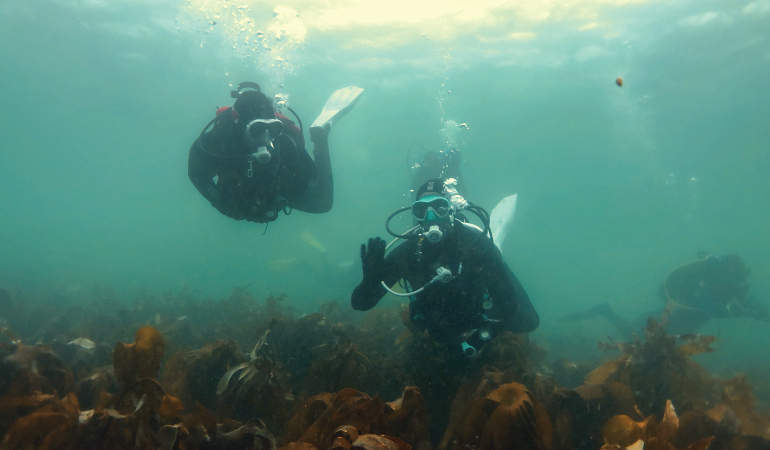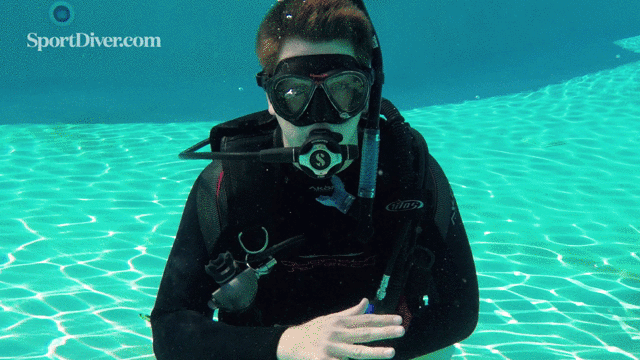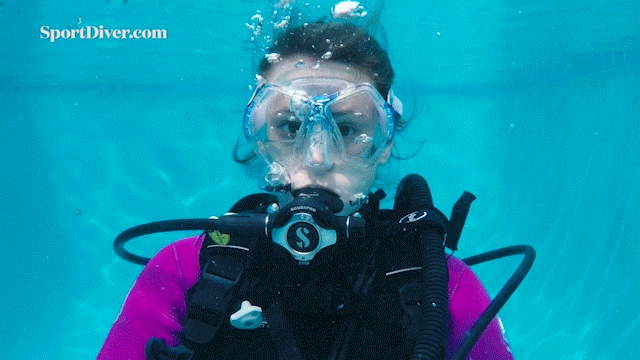
THE BUDDY SYSTEM FOR DIVING
Everything is better with a buddy, right?? When it comes to diving, the buddy system makes things easier, safer and more fun. In this article, I discuss the buddy system for diving and why it's so important.
The importance of planning the dive with your buddy
Planning your dive and communicating clearly (both on dry land and underwater) with your buddy is super important. Planning a dive allows you to understand and meet the desires and criteria of both you and your buddy. For example, if you want to see some awesome coral… plan to see some awesome coral!
Dive planning should be centred around you and your buddy's experience and comfort levels. If you're an Open Water diver and only certified to comfortably dive to 18 metres, don't let your Advanced buddy push you past your 18 metre limit. Just because they’re certified to 30 metres doesn't mean you have to be forced into deeper diving!
Diving should be an exciting experience for all and consideration on both parts is essential. Likewise, if you’re a baby diver but your buddy has LOADS of dives logged, be clear in communicating your comfort levels! It's really easy for more experienced divers to forget what it was like and how they felt as a newer diver. I'm sure they wouldn't push you out your comfort zone on purpose, but they might do it accidentally without even realising! Find a buddy who you feel comfortable confiding in if anything is worrying you.
You may also want to assign yourselves some roles such as the ‘leader’/ ‘navigator’ or ‘photographer’. This may mean that one buddy leads the dive if they know the spot a little more whilst the other follows. Likewise, one buddy may be responsible for taking some epic seal pics while the other keeps an eye out on navigation, trim and the surrounding environment!
Planning a dive and diving your plan helps the buddy system in diving work like a dream. Everyone understands their roles and the route to take on the dive.
Setting a dive objective
Setting a dive objective should be centred around you and your buddy's interests. This may include getting to a specific destination such as a wreck or reef, taking pictures and videos, practising skills or doing a litter pick.
Again, it's absolutely crucial that your objective also takes into consideration experience and comfort levels. This is hugely relevant when wreck diving. Often wrecks are a little deeper than reefs so if you're not certified to do the dive, save it until you are and set another objective! The underwater seascape is vast and there's so much to see and enjoy safely!
My biggest piece of advice for setting dive objectives is to keep it simple. Don't try and cram lots of things into one dive. Have one objective per dive to avoid overload and prevent having to rush around underwater in order to fit everything in. I've noticed that when things get more complicated, the buddy system for diving can start to fall apart a little bit. Plus, if you don't see everything on the site in one dive, it gives you and your buddy an excuse to go back down again!
How do you conduct the PERFECT buddy check?
Your dive is planned and you've got your kit on. Next comes possibly one of the most important parts of the buddy system for diving... the buddy check!
This was one of the first skills you learnt during your Open Water Course, and for good reason - you need to complete this before every single dive you do. And don't get complacent with it - just because you've got lots of dives under your belt doesn't mean you can skip your buddy check. This simple routine can catch a multitude of problems before you jump in. It prevents everything from the embarrassing "doh! I forgot my weights!" to things that could turn more serious like forgetting to turn your air.
Remember BWARF
BWARF is an acronym that will cover all your checks to ensure a safe dive.
- Begin With Review And Friend
- Burger With Relish And Fries
- Because We're Really All Fish
- Bruce Willis Ruins All Films
- and much ruder ones than those...
How do you remember your buddy check steps?
NEVER skip or rush your buddy check, the sea will always be there! So...lets break this down;
B- BCD
First, turn your air on (if it's not already). When checking your BCD, ensure that you can add and release air as you please via the inflator/deflator hose by inflating and deflating a few times. You should also manually inflate a few times to practise in case of an emergency. Remember, Don't forget about the dump valve(s) too! Test them to make sure they're working as designed
If you're like most of us at The Fifth Point who dive drysuit, apply a little air to your suit to ensure you can inflate if needs be and check your dump valve is open.
W- Weights
When checking your weights, make sure you have the right weights for you. For example, I use 2kg in each weight pocket so 4kg in total. Also, make sure you've placed them in comfortably and securely… we don't want them dropping onto and damaging the fragile coral! Likewise, you don't want to have to worry about and faff on with them underwater! Give either your straps or weight belt a gentle tug to ensure properly fastened.
A- Air
This is a SUPER important step! Air is what allows you to breathe underwater so you definitely want to make sure that this is working properly. At this point, take note of how much air you have in your cylinder - is it a full tank? You might also want to tell your buddy how much air you have.
Begin by breathing a few times naturally through your second stage also checking the purge valve and then repeat with your alternative air source.
As you're breathing, keep an eye on your gauge. That needle should be completely still. If it's dropping with every breath, your tank is closed. If the needle looks like it's bouncing, your tank is only partially open. If you see any kind of movement, investigate the problem.
R- Releases
Check that all your releases are accessible and properly fastened by giving them a gentle tug. For example, your weight pockets, weight belt and BCD straps.
This part of the buddy check is also for buddies to get familiar with each others kit. In an emergency (or if you just need a little bit of help getting out your kit at the end of a dive) it will help your buddy if you show them where all your releases are located and how to open them.
F- Final
Here you have the opportunity to make sure that all hoses are properly positioned and double-check they're not preventing access to other pieces of equipment eg. tangled under your weight belt. You can do a final head to toe check of you and your buddy ensuring that they’re ready to dive. Begin to collect equipment like fins,mask, snorkel and camera then aaaaahhhh… you're finally ready to explore the underwater world! Enjoy!
Emergency procedure review
Communication
Communication is key when diving so before a dive, ensure that you and your buddy are both on the same page in terms of hand signals. Some divers use different signals if they're tec or with another agency etc so it's better to be safe than sorry! You should also remember that ANYONE can end a dive at ANY time for ANY reason. If you feel something is wrong or you feel uncomfortable, signal to end the dive. NEVER feel intimidated by your buddy no matter their experience. And on the flip side, don't be that diver that makes their buddy feel uncomfortable, that's not cool dude!
If you feel something's not quite right, communicate this with your buddy. Again, it's better to be safe than sorry. To communicate that somethings wrong, open your hand flat, facing down and rotate/ oscillate as if you're saying Comme Ci, Comme Ça!

If you need to, thumb the dive.
There are many minor issues that may arise whilst diving such as ear clearing or being too cold. Make sure that you're familiar with the signals so that you can act immediately if either you or your buddy is having problems.
What to do if you lose your buddy
The key is not to panic! Losing your buddy puts you in a high pressure situation but if you both follow your PADI training, you will both be grand. You can even take the situation as a learning experience. Simply look around for 1 minute checking above and below doing a 360° spin and if you can't find them, ascend to the surface. Remember to check in that blind spot (behind and slightly over head) The number of times my buddy has been lurking here and I've not spotted them! You can avoid this problem if you discuss it as part of your dive plan. You could decided that you're going to stay side by side or one slightly ahead of the other.
What to do if you or your buddy is out of air
Hopefully, you and your buddy should never run out of air as you will have planned the dive and will both be checking your gauges often, leaving around 50 bar as safety at the end of the dive. However, if it did ever happen, you know what to do! PADI acknowledges that issues do arise and have created a universal hand signal to aid you in letting other divers know that you're out of air and in need of immediate help.
To signal to a diver that you're out of air, move your flat, downward facing arm directly across your throat in an almost ‘slitting’ motion. Make sure that this signal is big and clear, this way you can get immediate assistance. Likewise, if your buddy signals this to you… share your air!!!

To share your air, take control over your alternative air source calmly and allow your buddy to breathe from your second stage. If you’re super low on air and your buddy isn't near you, you may need to perform a CESA.
Hopefully this has given you some tips on how to be an epic buddy! Just remember to communicate and have fun! We hope to see you when we’re next under the waves!